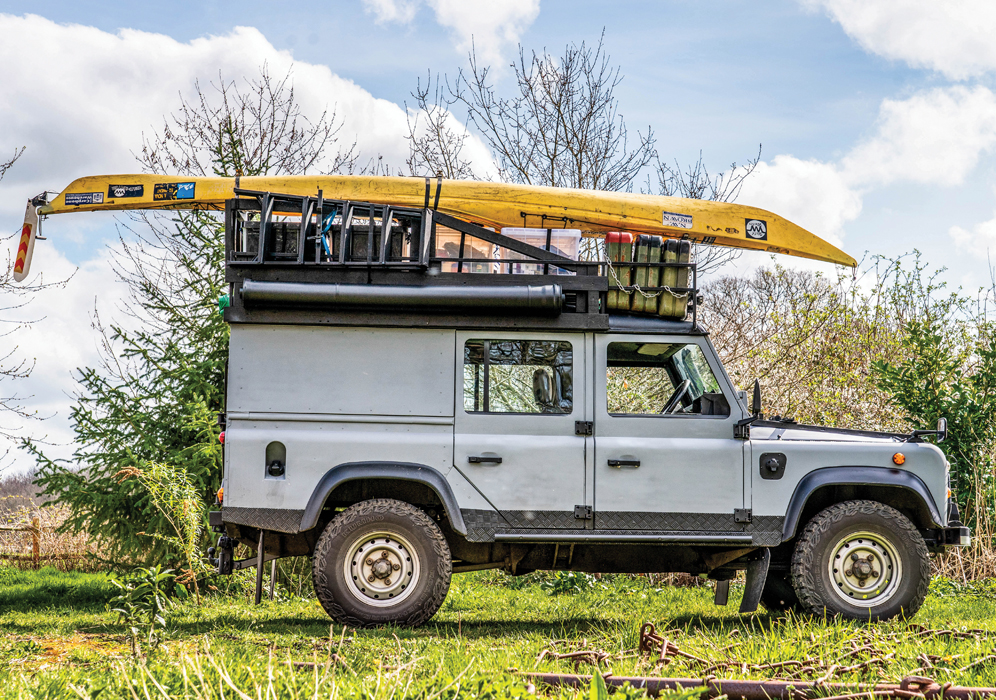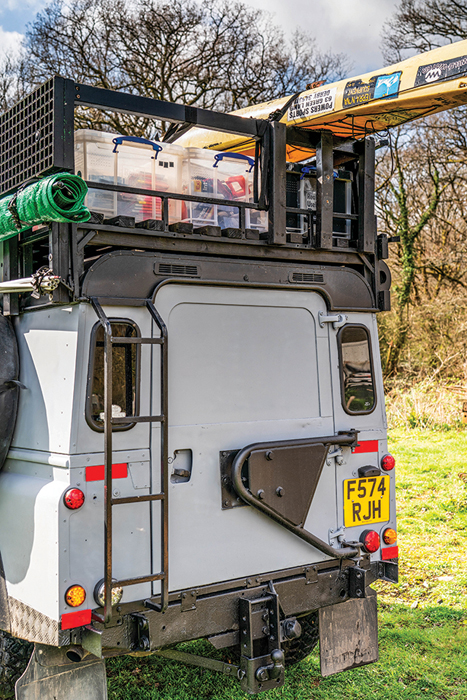25 May 2024
|
Ric Swift wants to relocate his Wildlife Film School from the UK to Africa, and his trusty One Ten is at the heart of his plans
Some of the most interesting stories about Land Rovers often come to light by chance, just like this one, although in this case it was my wife Fiona who made the connection, spotting what she thought was an interesting vehicle in the gym car park. “It was definitely a One Ten,” she revealed confidently when she got home, “but it had the biggest and chunkiest roof rack I’ve ever seen. I took a couple of photos of it for you.”

This 110 cuts an impressive profile
She handed over her phone and there it was, looming large in the sluicing rain and barely visible under the dim streetlamps. It seemed to be painted in an almost stealth-like matt grey that wouldn’t look out of place on a battleship and yes, it definitely had something very substantial on its roof, and something else that I couldn’t quite make out on its bonnet. It looked like it had been put together as a working tool with a very specific purpose in mind, which always piques my interest when it comes to Land Rovers.
“Anyway, I had a quick chat with the owner. His name’s Ric,” she told me, handing over a scrap of paper with a scribbled mobile number and an email address. A week later, I’m meeting Ric Swift to hear more about his One Ten.

Wooden floor and side frame create huge additional stowage capacity
“It was great to chat to Fiona when she took a liking to my Landy,” he smiles. “I have to say that people coming up to ask about it or take photos happens a lot, even though the vehicle’s actually not all that exciting. It’s a 1989 fitted with a 200Tdi, no suspension lift, no wheel widening, or anything else that isn’t absolutely necessary.

Wooden bonnet platform allows access to the roof rack
“What it does have, which is why so many people stop and take photos of it, is a very large, purpose-built roof rack, and a platform added to the bonnet to allow me to climb over it to gain access to the roof.

Rack accommodates 12 food boxes, six jerrycans, sea kayak and sometimes a mountain bike
“The roof rack is reinforced and extended because I travel with 12 large food boxes on it, along with six jerrycans on the front. On top of the food boxes, I carry a 16-foot sea kayak, and sometimes a mountain bike. So when the truck is fully loaded, it looks like it’s ready for some serious action!
“I bought it around ten years ago for £1000 on eBay, with a specific purpose in mind. It was in reasonable condition, with a sound engine and solid chassis, and has proved to be a very worthwhile purchase.

Winch bumper provides access to the bonnet platform
“After doing a lot of work on it, it is now in the condition it is today. When I bought the vehicle, the body was sitting on the axles (there weren’t any bump-stops) so we had to replace all of the suspension and added an additional set of springs at the rear to offer extra carrying capacity.

Functionality and practicality are core to Ric’s bespoke conversion
“I replaced all the wiring under the dash and fitted a new rear loom, and all the old glass fuses were replaced with blade fuses with a new fuse box. New alternator, fuel pump, door locks, and then during a recent service Keith Gott reset the tappets for me. I also fitted a dog guard to separate the film kit from the crew space and built the bespoke roof rack and a platform on the bonnet that I could walk on.

A power point and socket for every eventuality
“Originally it was white, but that’s not the ideal colour for a vehicle that’s being used for wildlife filming, and it is now matt grey. Halfords’ primer, actually! I reckon it’s got parts from at least nine different vehicles in it, but it does the job, and that’s what matters to me.

One Ten provides an ideal filming platform
“People who come over to look at it invariably ask why I built it and what I do with it, and the answer is that 15 years ago I launched the UK Wildlife Film School, and it was very quickly apparent that I needed a vehicle capable of fulfilling some very specific requirements. I take groups of up to four students several times a year to the highlands and islands of Scotland, where I teach them all the fundamental skills they need to produce a wildlife film on location.
“We have run wildlife film courses all over mainland Scotland including the Cairngorms, Inverness, Glencoe, Rannoch Moor, and the Ben Nevis range, as well as Mull, Skye, Arran, the Outer Hebrides, and the Shetland Islands. We have found ourselves returning to the Isle of Mull again and again, and we generally run at least one course a year there, simply because in my view it is the best location in the UK to see the widest range of wildlife, and it offers the chance to camp and film in stunning locations ranging from vast, beautiful, beaches to the mountainous and windswept open landscapes.
“The Land Rover’s job is to carry all the film equipment – and there’s a huge amount of that – as well as the wilderness camping gear and the food to allow the entire group to be completely self-sustaining for the duration of the course, which is usually four weeks but has been as long as 12. And once base camp has been established, the One Ten is then the sole means of transport to get the film equipment and the students to the required locations.

Wildlife Film School students Jasmine and Louis with the One Ten at base camp on the Isle of Mull
“Over three-quarters of our students are from outside the UK, but they all generally fly into Glasgow and then hop across to Mull, or wherever else we are running that particular course, and once they’re on location they – and I – are completely dependent on the Land Rover.
“At our peak in 2019, before the Covid lockdowns, we were teaching a Scottish Credit and Qualifications Framework (SCQF) Level 8 Diploma in Wildlife Documentary Filmmaking (the equivalent to an HND) over a 16-week course with an eight-week practical section on location in the middle. I am rather proud to say that this made us the only independent wildlife film school in the world where you could gain a university accredited, internationally recognised qualification.
“And the amount of gear that we need to transport has increased dramatically over the years. When we started in 2009, a course typically involved just two students, and we would have a single HD camera and tripod. Today, we have four large 4k cameras, full audio field recording equipment, two drones, several camera gimbals, a 3kW electric generator to power it all, and enough kit to sustain the group for as long as required.

Modifications to roof rack allow it to accommodate storage boxes and a sea kayak
“We carry all the film equipment and the generator in the rear of the vehicle. It’s a great space that even after the installation of a dog guard is still deep enough to load a broadcast-standard television camera with an 800mm lens with no issue whatsoever. Everything else has to go on the roof.
“Some of our Wildlife Film School students have gone on to gain employment with some of the largest wildlife and natural history production companies in the world,” he explains, “such as the BBC Natural History Unit and Films@59, and work on prestigious documentary series such as Our Planet with Sir David Attenborough. But it can be a tough business to get into. Something like 90 per cent of all media students who have studied some form of film or television production in the UK are still not actually working in either industry.
“I also launched an online community hub called the Wildlife Film Network, which is an international database of wildlife orientated people,” Ric says. “We welcome members who are writers, scientists, environmentalists and conservationists, as well as film production folk.

Mirror extensions ensure a clear rear view over side-mounted spare
“Since leaving the army I’ve worked as a freelance television camera operator for such establishments as the BBC, Meridian TV, Rapture TV, Granada, Sky TV and other major European broadcasters, plus corporate clients such as Animal UK, the British government and the Ministry of Defence. I have also worked as an outdoor pursuits instructor in hill walking, rock climbing, navigation, white water kayaking, canoeing, sailing and first aid.”
And what of the future? After 15 years in the UK, Ric reveals he wants to take the Wildlife Film School to Africa. “I’m in the early stages of planning and looking at logistics. My initial objective was to relocate to Tanzania as I lived in Arusha for a couple of years and filmed in the Serengeti and Tarangire National Park, as well as Lake Eyasi and the Arusha National Park. However, there is a significant issue, because Tanzania charges import tax at 100 per cent of the value of the equipment imported.
“I’m therefore also investigating alternative locations and Botswana and the Okavango Delta are looking very good. Botswana has a lot of systems in place similar to the UK and the import of vehicles is considerably cheaper at just 20 per cent of the value of the imported equipment, and the process seems to be less bureaucratic than Tanzania. If we relocate to Botswana, we can still drive overland through Zambia to run courses in Tanzania.

Simple DIY solution for side steps
“You’re probably wondering why I want to take the One Ten! I’ll have to ship it all the way by sea on the roll-on, roll-off service from Sheerness in Kent to Durban in South Africa, and then drive thousands of miles overland to our final destination. The reason is that I want to have a vehicle with me where I know its mechanical history and capabilities, rather than buying locally and hoping for the best. I also believe it is the best way to get all of my film equipment to Africa safely in one go as sadly, every time I have flown commercially, I have had my luggage broken into and an item or two of kit stolen.
“Once we’re in Durban, I’m planning to run film courses en route at locations such as the Kruger National Park, Namibia, the Kalahari and the Okavango Delta. We also plan to drive between filming locations in the Land Rover, which in turn will prove to be an adventure and experience in itself. It’s a seriously wiggly route to take to get to Tanzania, and a lot of mileage, but I’m sure it will prove to be a real adventure along the way. And at the end of the day, that’s what it’s really all about.”
It’s an exciting and ambitious plan, and Ric has promised to keep us updated as things take shape. We’ll be delighted to report on his and the team’s progress on this fascinating adventure.
See all other five parts of our Adventure Special here.
Like to have your own Land Rover library?
Try our All-Access Digital Subscription. You'll get access to over 7 years of Land Rover Monthly – that’s more than 100 issues plus the latest digital issue. All issues are fully searchable so you can easily find what you are looking for and what’s more it’s less than 10p a day to subscribe. Click the link above to find out more details and start enjoying all the benefits now.







